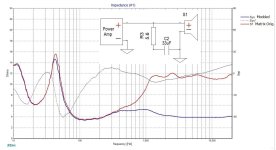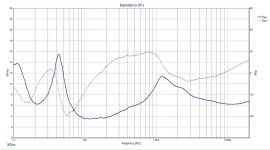It is difficult to measure large speakers, but you are primarily interested in the response of medium and high frequencies, and that part is not large. The tweeter and two mid drivers are relatively close. You can measure at 1m in the axis of the tweeter, at 1.5m, at the listening position, out of axis, etc. You have gating in the measurement to turn off everything below 200-300Hz to make measurement more realistic above 1kHz, etc. I say again, download Holmy Impulse, it's the easiest for the first time. REW is much more complicated because there are many options.
Thanks a lot for help. I will keep your instructions in mind.
Third option: Improve the compatibility of your chosen amp and speakers. This could be achieved by an impedance correction in parallel to the speaker. Maybe the aforementioned RC circuit is already enough. Maybe not. Measurements and some learning may be needed.
Regards
Charles
I see. I will take note of your comments too.
If the sensitivity of the mids is actually above 93 dB
If the specs account for peaks or trying for best published
numbers. Which is likely.
It would be minimal to no padding needed for the tweeters
Luckily the documentation is good from the pdf posted in post #91
The mids are already padded very slightly. So the factory crossover
is already padded and has component locations to fine tune any padding
needed.
Look as if one mid is crossed lower , which is good for vertical.
It could be somewhat not as painful to fix the high Q on the high pass.
and change the lowpass to blend with, new tweeter added.
Least it is not a complete shot in the dark, no reverse engineering is needed
the documentation is good.
View attachment 1460439
Thanks for your explanations.
To be honest, I cannot yet understand 100%
what you explained. But, very helpful for me.
Just out of curiosity, what would my estimate of a 4uf cap, and 12 ohm resistor look like? I was going for about 8 ohms up top.This modification should reduce the tweeter level some 2dB assuming amplifier output impedance in the range of 2 ohms,
even more the greater the OI.
View attachment 1460458
Last edited:
Hi there,
the thread is getting very interesting, i really like the original PDF from B & W for the affected speaker model
the fact that some other professional builders are offering modifications for thie speaker suggest that there is a pay off to try
my last suggestion for a more non technical person for this is to start to train you ears with really decent near field monitors on the desk, like the Genelec's or the K+H studio monitors
before i end up in buying measurement equipment i used this simple "trust your trained ears" approach for years with some small Genelec's at my desk
but on the other hand the measurement equipment opened to me a completely new more reliable approach
other idea is to borrow a pre amplifier that offers a good Dirac Full Range signal correction integration and to take the measurements with this tool
i used the miniDSP Flex 8 DL in a 6 way open baffle / multi horn proof of concept and was astonished to hear the result, i would be never able to tweak the system this way by hand
good luck!
- Stefano
the thread is getting very interesting, i really like the original PDF from B & W for the affected speaker model
the fact that some other professional builders are offering modifications for thie speaker suggest that there is a pay off to try
my last suggestion for a more non technical person for this is to start to train you ears with really decent near field monitors on the desk, like the Genelec's or the K+H studio monitors
before i end up in buying measurement equipment i used this simple "trust your trained ears" approach for years with some small Genelec's at my desk
but on the other hand the measurement equipment opened to me a completely new more reliable approach
other idea is to borrow a pre amplifier that offers a good Dirac Full Range signal correction integration and to take the measurements with this tool
i used the miniDSP Flex 8 DL in a 6 way open baffle / multi horn proof of concept and was astonished to hear the result, i would be never able to tweak the system this way by hand
good luck!
- Stefano
That's what I do as I make one change at a time and live with it for a while before proceeding to others.I am generally of patient nature. So, I usually change
just a little bit and then hear the sound for weeks or
months to determine the results.
before i end up in buying measurement equipment i used this simple "trust your trained ears"
I would approach this the other way round: first the evaluation by measurement technology, then perhaps changes based on taste/your own hearing.but on the other hand the measurement equipment opened to me a completely new more reliable approach
In my experience, every human sense is so easily fooled that I clearly prefer the order I mentioned above. Most of the time, by the way, changes were hardly necessary after listening.
Btw. and in case it hasn't been mentioned yet: among other things, it also seems to be about measuring the sensitivity of drivers. Level calibration is necessary for this, for which there are various possibilities. I myself use a sound level calibrator.
whats up with the 2 bumps in the impedance curve with tweeter? one seems higher than expected given a recommended cross at 2k, the other much lower than expected for Fr.
- Home
- Loudspeakers
- Multi-Way
- Tweeter Selection for B&W Matrix 800

